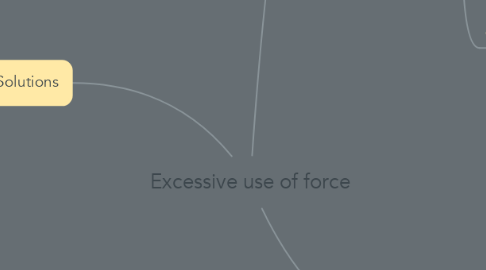
1. Solutions
1.1. Trainings
1.1.1. Bias training
1.1.2. Mental health concerns
1.1.3. Training evaluations
1.1.4. De-escalation training
1.2. Building Trust and Legitimacy
1.2.1. Aknowledge past discrimination
1.2.2. Cultural of transparency
1.2.2.1. Make policies transparent
1.2.3. Anonymous peer reviews
1.3. Technology and Social Media
1.3.1. utilize twitter and social media for real time response to crime
1.3.2. Utilize technology for real time reporting data
1.4. Policies
1.4.1. Excessive use of force policy
1.4.1.1. evaluations
1.4.2. Collaborate with community to create policies
1.4.3. Should collect and report data
1.4.4. Organizational structure to create change
1.4.5. De-escalation policy
1.5. Community Policing
1.5.1. Community engagement in policies
1.5.2. Community involvement in organizational structure
1.6. Officer wellness
1.6.1. Mental health checks
1.6.2. Therapy systems for officers
2. Stakeholders
2.1. KCPD
2.1.1. Administration
2.1.2. Police officers
2.1.3. Police Chief
2.1.4. Values
2.1.4.1. police officer safety
2.1.4.2. protecting the citizens
2.1.4.3. police officer rights
2.2. Community members
2.2.1. Communities of color
2.2.2. Values
2.2.2.1. Voice
2.2.2.2. Trust
2.2.2.3. Safety
2.3. Local government
2.3.1. City council
2.3.2. Values
2.3.2.1. Re-election
2.3.2.2. Trust
2.3.2.3. Community engagement
2.3.2.4. Stewardship for police cheifs
2.4. Community organizers
2.4.1. BLM Movement
2.4.2. ACLU
2.4.3. Values
2.4.3.1. Safety
2.4.3.2. Protection
2.4.3.3. Voice
2.4.3.4. Protection of citizens' rights
3. Causes
3.1. No clarity in definition
3.1.1. Little clarity in policies
3.1.1.1. policies aren't public
3.2. Officer training
3.2.1. bias training
3.2.2. de-escalation training
3.3. Potential biases
3.4. Emotional responses
3.4.1. sensory deprivation
3.5. Lack of organizational structure
3.5.1. communcation
3.5.2. reporting structures
3.5.3. reprimands
